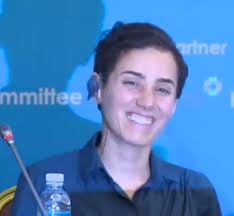Maryam Mirzakhani
by Krešo Josić
Today, let's talk about the Iranian-American mathematician Maryam Mirzakhani. The University of Houston presents this program about the machines that make our civilization run, and the people whose ingenuity created them.
The international mathematics community was recently shaken by news of the death of Maryam Mirzakhani, one of the foremost mathematicians of her generation. Although she died much too young at the age of 40, she had already achieved more than most mathematicians do in a lifetime.
Mirzakhani grew up in Iran. Initially not very interested in mathematics, by the age of 17 she had already won the gold medal in the International Mathematics Olympiad. After completing her undergraduate degree at Sharif University, she came to the US to work on her PhD at Harvard.

Maryam Mirzakhani Photo Credit: Wikipedia
Mathematics has a long history. As a result many problems have been mulled over by scores of people over hundreds of years. This makes it quite daunting for students trying to make their first original contributions. However, Mirzakhani was fearless, and tackled some of the hardest problems in mathematics early on. Her tenacity is legendary, and she worked on problems over many years. Her perseverance paid off. By the tie she finished her PhD she had already solved two longstanding problems in mathematics.
Some of Mirzakhani's most influential work studied paths called "geodesics". Imagine an ant walking along a surface. If the ant moves straight ahead without turning left or right, it follows a geodesic. On a flat surface, the ant walks in a straight line. If the surface is curved, the ant's path curves with it. On a sphere, for example, the ant walks along a "great circle" which gives the shortest path between two points on the sphere's surface; at a larger scale, these great circles determine the routes flown by airplanes on long journeys.

Maryam Mirzakhani, August 2014 Photo Credit: Wikipedia
On other surfaces, geodesics can be more complicated. An ant walking along a geodesic on a donut can wind around the donut's surface in a complicated way. It may eventually come back to where it started and continue traveling along the same path it just traversed. Or it may wander forever, coming close to, but never quite hitting the point from which it began its journey. Modern physics tells us that space itself is curved. Thus geodesics are also fundamental to understanding the shape of the universe we live in.
Mirzakhani studied geodesics using the mathematical theory of "moduli spaces". This is a very powerful, but difficult, theory that provides insights not just into geodesics and geometry, but also into many other areas of mathematics and physics ranging from number theory to quantum gravity.
In 2014, Mirzakhani was awarded the Fields Medal, the highest honor in mathematics. She was the first woman to win this award. But for her colleagues in the mathematics community, her legacy will be the beautiful mathematics she produced, as well as her incredible tenacity, optimism, and vision.
I'm Krešo Josić with my University of Houston colleague, Vaughn Climenhaga, and we're interested in the way inventive minds work.
(Theme music)